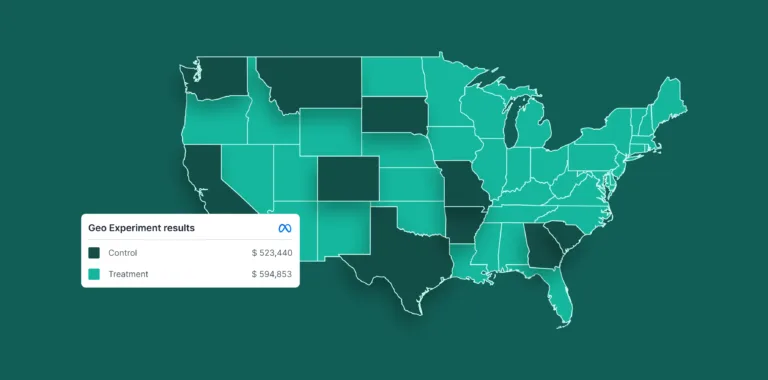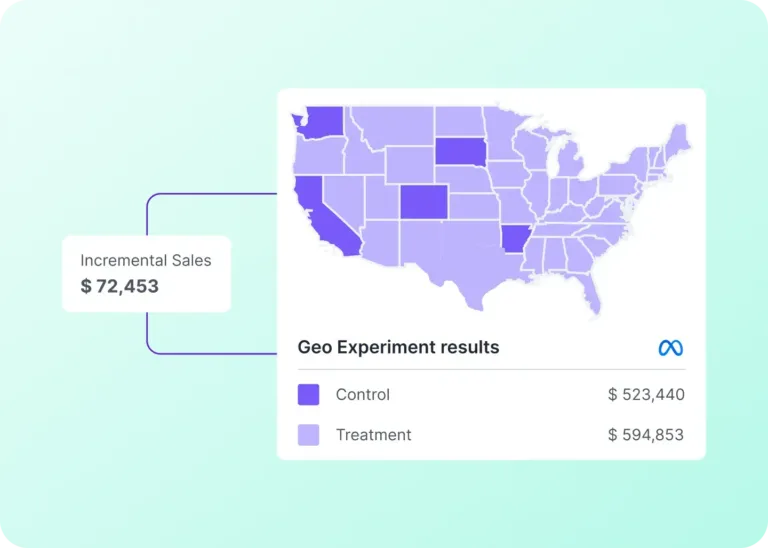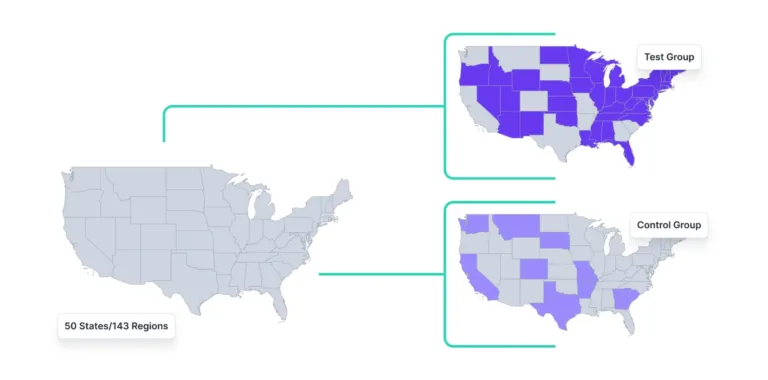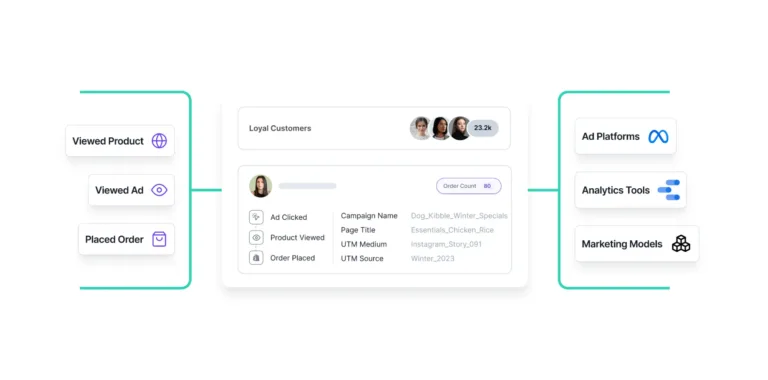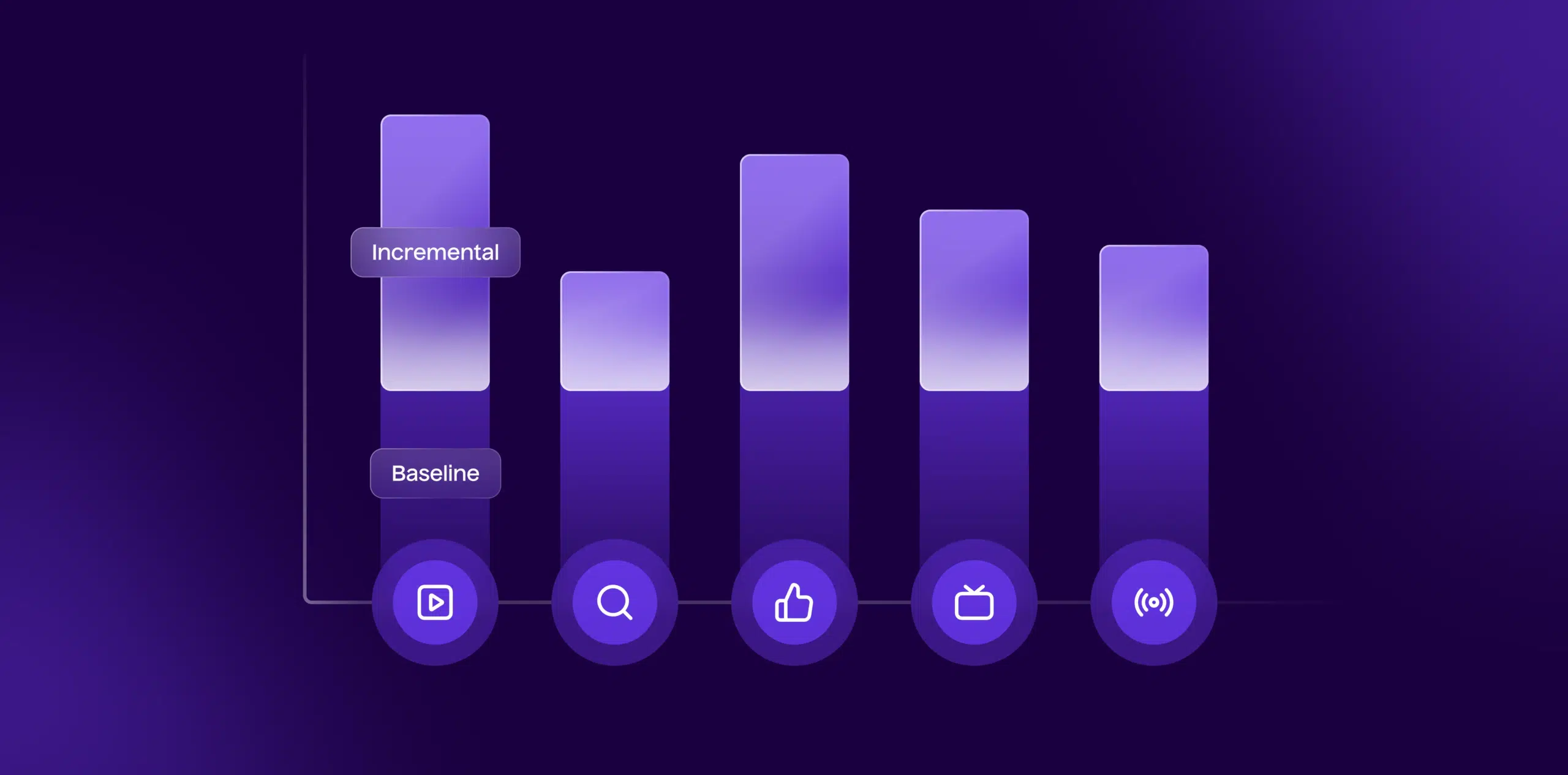As marketers and CMOs prepare their strategies and budgets for 2025, one key question rises to the top: How can we drive profitable growth in an increasingly privacy-first world? The answer lies in understanding which marketing channels truly deliver results, quantifying their impact, and optimizing budget allocation to maximize return.
With user-level tracking becoming less reliable due to regulations like GDPR and CCPA, and the upcoming deprecation of third-party cookies, measuring the true impact of advertising has become more challenging. Incrementality testing has become the industry standard for gauging real results, and among the most effective, privacy-safe methods today is geo experimentation.
Geo experiments allow marketing teams to isolate and measure the performance of campaigns by comparing geographic regions with different levels of exposure. This method doesn’t rely on cookies or personal data, ensuring compliance while still offering statistically robust insights. Major brands are already leveraging geo testing to evaluate the effectiveness of digital, CTV, OOH, and new product launches.
In addition to measuring direct campaign outcomes, it’s crucial to consider the post-treatment, or “cool-down” period. This phase, which follows the active campaign, provides valuable insights into the delayed effects of marketing efforts, capturing longer-term consumer behavior that isn’t immediately visible. Including this in your measurement approach ensures a comprehensive understanding of campaign performance.
In this guide, we’ll explore why geo experiments are becoming a cornerstone of performance marketing in 2025 and how they can help you make smarter, more profitable marketing decisions.
Here’s a detailed video explanation of ‘Geo Testing and Experiments’ by Rajeev Nair, Industry Thought Leader and Co-founder of Lifesight.
What is a Geo-Based Experiment?
A geo-based experiment, also known as a geolift test, is a marketing measurement technique that enables you to analyze the true impact of your advertising efforts within specific geographic markets. By dividing regions into a treatment group (where the treatment is conducted) and a control group (where things are kept business as usual), marketers can accurately isolate the incremental lift of a campaign without relying on individual-level tracking. This approach is especially valuable in today’s cookieless, privacy-first environment.
Geo Experiments and Testing Examples
Geo experiments are widely used across industries to measure the marketing effectiveness of campaigns and optimize media spend.
Let’s say some common examples of how geo testing is applied in real-world marketing scenarios:
1. Digital Marketing Campaigns
An advertiser could target digital ads like paid social or search campaigns to specific cities. Running geo experiments helps measure how these campaigns drive conversions beyond organic growth.
2. TV Advertising Campaigns
A company might run a TV ad campaign in certain regions while not running that particular ad in the other regions. By comparing these areas, they can measure the incremental lift in brand awareness, sales, or website traffic caused by the campaign.
3. Out-of-Home (OOH) Advertising
A business may test billboards or transit ads in select geographic areas. This helps them understand the impact on store visits or local sales compared to regions without the ads.
4. Product Launches
When launching a new product, a company might introduce it in a few select cities first. By comparing sales and customer feedback from launch and non-launch areas, they can assess market readiness and fine-tune the wider rollout.
5. Promotional Offers and Discounts
A retailer may run exclusive promotions in certain regions. Geo testing helps evaluate how these offers influence purchasing behavior compared to regions without promotions.
Use Cases of Geo Experiments for Modern Marketers
1. How a Personal Care Brand Used Geo-Experiments to Drive Smarter Spend and Higher Returns?
One standout example comes from a Texas-based personal care brand that used geo-experiments to overcome stagnating growth and unclear media attribution. By isolating regions and testing specific marketing tactics, the brand confidently increased its ad budget by 13% and achieved a 3.1X improvement in marketing efficiency. Geo-testing revealed the true incremental value of each channel, helping the team reallocate spend toward high-performing strategies like social, PPC, and email.
Explore the full case study to see how geo-experiments can drive measurable impact and smarter budget decisions.
2. How Incrementality Testing Helped an E-Commerce Brand Boost ROI by 20%
A fast-growing e-commerce brand turned to incrementality testing to uncover the true value of its marketing channels. By setting up a quasi-experimental design across email, search, social media, and affiliate campaigns, they identified where the budget was truly driving conversions. Unlike traditional randomized control trials, the quasi-experimental approach leveraged naturally occurring groups, such as geographic regions with varying levels of exposure to the campaigns, allowing for a reliable comparison without requiring personal data or cookies.
The results were surprising: email delivered the highest incremental impact, outperforming heavily funded social media efforts, while affiliate and search showed moderate value. Armed with these insights, the brand reallocated spend, scaled up high-performing channels, and saw a 20% increase in ROI the following quarter.
Explore the full case study to see how incrementality testing turned guesswork into growth.
See Lifesight in Action – Automate Geo Experiments Like Never Before.
The Role of Geo Tests in Measuring Advertising Impact
Now, you might wonder how geo tests fit into the grand scheme of measuring advertising impact. Traditional methods like multi-touch attribution (MTA) are losing their effectiveness due to stricter privacy regulations and the impending third-party cookie phase-out. Geo-tests fill this gap.
They are reliable tools for measuring causal impact or “incrementality.” This concept is at the heart of advertising impact assessment. It helps you answer a fundamental question: How much of your KPIs can be attributed to your advertising efforts, and how much would you have achieved without them?
They enable you to differentiate between the audience that was exposed to your ads and the audience that would have acted the same way without them.
And the best part? They can be run on both digital – social media, paid ads, and offline mediums – TV, radio, OOH, mail, etc.
For instance, a Texas-based women’s lifestyle and personal care brand was facing an issue of stagnant growth and was struggling to quantify the real impact of its diverse media channels and tactics on the business’s bottom line. They opted to conduct Geo tests and understand the true revenue drivers for their brand.
The result? A 3.1x uplift in their marketing efficiency. We recommend you read the full case study to understand how they did it.
Types of Geo Experiments in Marketing
There are various types of geo experiments based on campaign goals and data availability.
These can be broadly categorized into two types, which are common geo experiments type and advanced geo experiments type:
1.1 Geo Lift Tests
- Geo Lift Tests compare two groups of geographic regions: one exposed to the marketing campaign (treatment) and one that is not (control).
- By measuring the difference in key metrics such as orders or sales between these groups, marketers can estimate the incremental lift caused by the campaign.
- This approach helps understand how much the campaign contributed beyond what would have happened naturally.
1.2 Geo Holdout Tests
- Geo Holdout Tests involve purposely keeping some regions from being exposed to the campaign during the test.
- These “holdout” areas serve as a baseline to compare against the regions where the campaign is running.
- This method helps confirm any uplift observed in the treated regions is actually due to the campaign and not influenced by other factors.
1.3 Geo Split Tests
- Geo Split Tests run different marketing strategies in separate geographic regions to determine which one performs better.
- For example, one region might receive ads with a new creative, while another is shown the old version.
- This approach allows marketers to compare different tactics or messaging in real-world conditions.
1.4 Geo Brand Awareness Tests
- Geo Brand Awareness Tests aim to measure how marketing influences brand perception in specific geographic areas.
- Marketers often use surveys or brand lift studies in regions with and without ads to determine if awareness or favorability has increased as a result of the campaign.
1.5 Multi-Cell Experiments
- This involves dividing regions into multiple groups (cells), each receiving a different campaign variant or spending level.
- This allows testing several variables simultaneously, helping marketers decide which combination works best.
Why Geo Experiments Matter for Modern Marketers?
The benefits of geo experiments and geo testing includes;
1. Accurate Measurement
Geo experiments help marketers clearly see how well their campaigns work and give a more precise understanding, contrary to conventional methods that try to guess what caused the results.
2. Measuring Incremental Lift
These tests help to give a clear distinction between the true incrementality of the campaign and what would have happened anyway. This helps marketers know the true value of their advertising efforts.
3. Better Use of Budget
By knowing which places have the most potential for marketing, marketers can spend their money where it will have the biggest impact instead of wasting it in less effective areas.
4. Smarter Decisions
Data from geo experiments helps marketers decide which channels to focus on and where to put their efforts for maximum results.
5. Protecting Privacy
Geo experiments don’t rely on tracking individual users, so they work well even as privacy rules get stricter. They use group-level data, which is safer and respects user privacy.
6. Checking Marketing Mix Modeling
Marketers can use geo-tests to double-check the accuracy of their marketing mix models (MMM) by comparing it’s impact with real-world results.
Read About: Best Marketing Mix Modeling (MMM) Software Tools in 2025
7. Understanding Halo Effects
Geo experiments can show if advertising in one channel helped boost performance in another channel, giving a full picture of how marketing efforts work together.
How Do Geo Experiments Work? A Step-by-Step Workflow
STEP 1: Define your objectives
The first aspect of defining objectives involves identifying Key Performance Indicators (KPIs) that align with your overarching marketing goals. These metrics can vary depending on the nature of your business, the specific campaign objectives, and the stage of the customer journey. Common KPIs however include sales uplift, website traffic, and brand awareness.
Once KPIs are identified, the next step is to set clear and actionable goals for the Geo Experiment. These goals should articulate what you aim to achieve through the experiment and provide a framework for measuring success.
When setting goals, consider the following:
1. Specificity
Ensure that goals are specific and clearly defined, leaving no room for ambiguity. For example, instead of aiming to “increase sales,” specify the desired percentage or dollar amount of sales uplift.
2. Relevance
Align goals with broader business objectives and strategic priorities. Each goal should contribute to the overall success of the organization.
3. Achievability
Set realistic and attainable goals that are within reach based on available resources, market conditions, and historical performance.
4. Time-bound
Establish a timeframe for achieving goals to create a sense of urgency and accountability. This helps maintain focus and drive momentum throughout the experiment.
By setting clear and measurable goals, marketers can effectively track progress, evaluate performance, and make informed decisions to optimize campaign outcomes.
STEP 2: Select geographic regions
When choosing geographic regions for the experiment, it’s essential to consider various factors that influence the effectiveness and representativeness of the results.
Some key criteria for selection include:
1. Market size
Evaluate the size of the target market within each region to ensure an adequate sample size for meaningful analysis. Larger markets may offer greater potential for significant insights but require more resources.
2. Customer demographics
Understand the demographic characteristics of each region’s population, such as age, gender, income level, and lifestyle preferences. Select regions that closely match the demographics of your target audience to ensure relevance and accuracy.
3. Prior marketing performance
Review historical marketing performance data for each region to identify areas with higher engagement, conversion rates, or customer loyalty. Prioritize regions that have demonstrated favorable outcomes in past campaigns, indicating potential for success in the current experiment.
Once the regions are identified, it’s crucial to establish control and test groups to facilitate comparison and analysis. The control group consists of regions where no marketing intervention will occur, serving as a baseline for measuring natural fluctuations in performance. On the other hand, the test group comprises regions where the marketing campaign will be implemented, allowing for the evaluation of the campaign’s impact.
To ensure the validity and reliability of the experiment results, it’s essential to carefully balance the composition of control and test groups.
Factors to consider include:
1. Randomization
Randomly assign regions to control and test groups to minimize selection bias and ensure that both groups are representative of the overall population.
2. Equivalence
Ensure that control and test groups are comparable in terms of demographic characteristics, market size, and other relevant factors. This ensures that any differences in outcomes can be attributed to the marketing intervention rather than external variables.
3. Geographic proximity
Consider geographic proximity when selecting regions to minimize potential confounding variables such as regional economic conditions or cultural differences.
STEP 3: Ensure data readiness
The first aspect of data readiness is confirming that robust data collection mechanisms are in place to capture relevant information throughout the experiment. Depending on the objectives and scope of the experiment, data collection methods may include in-store sales tracking, online interaction monitoring, or survey instruments.
By ensuring comprehensive data collection mechanisms are in place, marketers can capture a holistic view of customer interactions and campaign performance across different channels and touchpoints.
In addition to data collection, it’s crucial to assess the quality and integrity of the data to be used in the analysis. Poor data quality can undermine the validity and reliability of experiment results, leading to inaccurate conclusions and flawed decision-making. To ensure data integrity, ensure that your data is accurate, complete, and consistent.
Regular data audits and validation checks should be conducted throughout the experiment to identify and address any issues promptly.
STEP 4: Design the experiment
This step involves ensuring consistency in campaign execution across regions while allowing for the manipulation of the variable being tested.
While the experiment may focus on testing a specific marketing intervention or strategy, it’s important to keep all other aspects of the campaign uniform across both test and control groups. This includes elements such as messaging, channel selection, and offer and promotion.
The timing of the experiment is another crucial consideration that impacts its validity and relevance. You must decide on the duration of the experiment, taking into account factors such as seasonality, campaign objectives, and the expected timeframe for observing results.
Key considerations include:
1. Duration
Determine the length of time over which the experiment will be conducted. Ideally, the experiment should run for a duration that allows for sufficient data collection and observation of meaningful trends or patterns. Shorter experiments may fail to capture long-term effects, while overly prolonged experiments may incur unnecessary costs or delays in decision-making.
2. Seasonal factors
Consider any seasonal variations or trends that may influence campaign performance. For example, a retail promotion targeting holiday shoppers may need to be timed to not coincide with peak shopping periods to maximize effectiveness.
3. Lead time
Factor the lead time required for campaign planning, implementation, and data collection. Depending on the complexity of the campaign and the channels involved, sufficient lead time may be necessary to ensure smooth execution and accurate results.
STEP 5: Execute the campaign
Launching the campaign simultaneously in both the test and control regions is essential to avoid time-based biases and ensure the integrity of the experiment. By initiating the campaign at the same time across all regions, marketers minimize the risk of external factors influencing the results.
Here are some things to consider while rolling out the campaign:
1. Coordination
Ensure proper coordination and synchronization of campaign activities across all regions. This may involve aligning timelines, communicating with stakeholders, and coordinating with internal teams or external partners to ensure a smooth launch process.
2. Rollout strategy
Develop a rollout strategy that outlines the specific tactics, channels, and messaging to be used in the campaign. Consider factors such as audience segmentation, channel preferences, and messaging tone to tailor the campaign for maximum effectiveness in each region.
3. Testing procedures
Conduct thorough testing and quality assurance checks to ensure that all campaign elements are functioning correctly before the official launch. This includes testing links, verifying tracking codes, and reviewing creative assets to identify any potential issues or discrepancies.
Once the campaign is underway, it’s essential to monitor its progress closely to ensure that it aligns with the planned strategy and objectives. Continuous monitoring allows marketers to identify any deviations from the plan and make timely adjustments to optimize campaign performance.
STEP 6: Collect and analyze data
Collecting and analyzing data is a critical phase of the Geo Experiment process, as it allows marketers to assess the impact of the campaign and derive actionable insights for optimization.
Thanks to all ad platforms, your marketing data might be spread across as many platforms as you can imagine. This might lead you to wonder whether you can get all your data in one place and if yes, how.
You would be glad to know that there is an answer, or rather a product that can help you collect data from various sources, including online and offline channels, to gain a comprehensive understanding of all your campaign performance.
It’s called Lifesight’s Unified Marketing Measurement.
Lifesight enables seamless integration and aggregation of data from sources such as:
1. Online interactions
Data from digital platforms including website analytics, social media engagement metrics, and online advertising impressions.
2. Offline transactions
Such as in-store sales transactions, store visits, and direct mail responses.
3. Third-party sources
Such as demographic data, market research insights, and competitive intelligence.
By aggregating all these data points from various sources, Lifesight helps marketers obtain a unified view of campaign performance and customer behavior, enabling more informed decision-making and optimization.
Read More About: What is Unified Marketing Measurement?
STEP 7: Interpret results
One aspect of interpreting results involves evaluating the incremental impact of the campaign by comparing key performance indicators (KPIs) between the test and control groups. Marketers should analyze the KPIs set in step one and see how the test has impacted them.
By comparing the KPIs between the test and control groups, marketers can quantify the impact of the campaign and determine its effectiveness in achieving the desired objectives.
In addition to evaluating KPIs, marketers should also look for trends or patterns that emerge from the data. Analyzing trends can provide deeper insights into customer behavior, market dynamics, and campaign performance.
Key considerations include:
1. Seasonal variations
Seasonal variations in consumer behavior, market demand, or external factors can influence campaign effectiveness and should be taken into account during analysis.
2. Geographic differences
Compare performance metrics across different geographic regions to identify regional variations or trends. Understanding regional differences in customer preferences, behavior, and market conditions can inform targeted marketing strategies and tactics.
3. Campaign segmentation
Analyze performance data by segmenting the audience based on demographic, psychographic, or behavioral characteristics. Identifying high-performing segments or audience segments with unique preferences can guide future targeting and messaging strategies.
STEP 8: Apply learnings
You’ve finally completed the experiment and unearthed some interesting insights that can lead to better ROI. Now, you need to apply them strategically.
One aspect of applying learning involves using the insights gained from the experiment to adapt and refine future marketing strategies. Analyze the experiment results to identify successful tactics, audience preferences, and campaign elements contributing to positive outcomes.
This can help you increase efficiency and drive better results in future marketing campaigns.
Another aspect of applying learnings involves deciding whether to scale the campaign to other regions or make modifications based on the results. If you do decide to scale it to other regions.
Consider the following:
1. Scaling success
If the experiment results indicate a positive impact and strong performance, consider scaling the campaign to additional regions or markets.
2. Modifying strategies
If the experiment results reveal areas for improvement or indicate suboptimal performance, consider making modifications to the campaign strategy, tactics, or execution.
3. Piloting new initiatives
Use learnings from the experiment to inform the development and piloting of new marketing initiatives or innovations.
By scaling successful campaigns and modifying strategies based on experiment results, you can drive continuous improvement, optimize resource allocations, and maximize the impact of your marketing efforts.
STEP 9: Document and share findings
Documenting and sharing findings from the geo experiments is essential for capturing insights, facilitating knowledge transfer, and informing broader marketing decisions.
The first aspect of documenting findings involves creating a detailed report that outlines the experiment process, methodology, analysis techniques, and key findings. The report should provide a comprehensive overview of the entire experiment lifecycle including experiment objectives, methodology, data analysis, insights and recommendations, limitations, and considerations.
By documenting the experiment process and findings in a comprehensive report, marketers can ensure transparency, accountability, and replicability of the experiment results.
Once the report is prepared, the next step is to share the findings with relevant stakeholders to inform broader marketing decisions and strategy development.
Stakeholders may include:
1. Senior leadership
Present the findings to senior management and executives to communicate the impact of the experiment and its implications for overall business strategy and objectives.
2. Marketing team
Share the findings with the marketing team to disseminate learnings, foster collaborations, and align future efforts with experiment results.
3. Cross-functional teams
Engage cross-functional teams, such as product development, sales, and customer service, to ensure alignment and integration of marketing insights into broader organizational initiatives.
4. External partners
Collaborate with external partners, such as advertising agencies, media partners, or vendors, to share learnings and optimize collaboration for future campaigns.
STEP 10: Plan for future experiments
Planning for future experiments is essential for continuous learning, improvement, and innovation in marketing strategies.
One aspect of planning for future experiments involves using the learnings from the current experiment to inform and guide the design and execution of future experiments.
Adopt an iterative approach to experimentation, systematically testing and refining hypotheses based on learnings from previous experiments. This approach can help marketers build on past successes, address shortcomings, and continuously improve their marketing strategies through experimentation.
Another aspect of planning for future experiments involves considering opportunities to expand the scope of experimentation by testing different variables or exploring new geographic regions.
You can either experiment with different variables, such as messaging variations, offer types, pricing strategies, or targeting criteria, to understand their impact on campaign performance. Or you can consider expanding experimentation to new geographic regions or markets to test the scalability and transferability of marketing strategies.
What are the Actionable Strategies from Geo Experiment Outcomes?
1. Translating data into marketing strategies:
Marketers can pinpoint the specific tactics that drive success by comparing the performance of test and control regions. This could involve identifying the types of promotions that resonate most with certain demographics or understanding the impact of ad placements on consumer behavior. The key is to dive deep into the data, looking beyond surface-level metrics to uncover actionable insights that can inform more targeted, effective marketing strategies.
2. Calibrating MMM with the experiment result:
Marketing Mix Modeling (MMM) is an invaluable tool for optimizing marketing spend across various channels and strategies. By incorporating the insights gained from geo experiments into MMM, marketers can achieve a more nuanced understanding of their campaigns’ effectiveness. This involves using geo-experiment outcomes to adjust the weights assigned to different marketing channels within the MMM. For example, if a geo experiment reveals that in-store promotions significantly outperform online ads in certain regions, this insight can be used to recalibrate the MMM, potentially allocating more budget to in-store activities in similar markets.
Best Practices for Running a Geo Test
Running a geo test effectively is crucial for gaining accurate insights into the effectiveness of your marketing strategies. Whether you’re conducting a holdout test (suppressing ad spend) or a growth/scale test (increasing spending), following best practices is key to ensuring meaningful results:
1. Decide on the Type of Test
- Holdout test: This involves reducing or completely halting ad spend in a selected market to observe the impact on performance metrics like sales or conversions. This test helps in understanding the baseline performance of a market without the influence of specific advertising efforts.
- Growth/Scale test: Contrarily, this test requires increasing the ad spend in a market to assess the impact on the same performance metrics. It’s useful for understanding the scalability and effectiveness of your advertising strategies.
2. Measure the Lift Accurately
During and after the test, focus on measuring the ‘lift’ – the change in key performance indicators (KPIs) due to your testing strategy. This involves closely monitoring metrics like sales volume, conversion rates, and customer engagement in both the test and control markets.
Accurate measurement of lift is critical to determine the success of the test and to gain insights into market responsiveness to your advertising efforts.
3. Analyze Incremental ROAS (iROAS)
Incremental Return on Ad Spend (iROAS) is a vital metric that measures the additional return generated for every extra dollar spent on advertising in the test market.
For example, if TOF (Top of Funnel) Meta ads in the test market show an iROAS of 3.5, it indicates a higher efficiency compared to BOF (Bottom of Funnel) branded Google search ads with an iROAS of 1.0.
4. Consider Incremental CAC (iCAC)
Incremental Customer Acquisition Cost (iCAC) should also be evaluated, especially for acquisition channels. This metric helps in understanding the cost-effectiveness of acquiring new customers through different advertising channels during the test.
Monitoring iCAC alongside iROAS provides a comprehensive view of both the cost and return of your advertising investments.
5. Apply Insights to Budget Allocation:
Use the insights gained from the geo test to make informed decisions about budget allocation across different advertising tactics.
For instance, if the test reveals that TOF tactics yield a higher iROAS compared to BOF tactics, consider reallocating your ad budget to prioritize TOF strategies.
6. Maintain Rigorous Data Monitoring and Analysis:
Throughout the test, maintain a rigorous approach to data collection, monitoring, and analysis. Ensure that the data is accurately captured and reflects the true performance of the test.
7. Ensure a Fair and Unbiased Test Environment:
Avoid any external influences that could skew the results. This includes maintaining consistency in other marketing activities across test and control markets to ensure that the observed effects are solely due to the changes in ad spend.
8. Post-Test Analysis and Continuous Learning:
After the test, thoroughly analyze the results to understand the broader implications of your findings. Use these insights for continuous improvement in your advertising strategies.
Navigating Risks in Geo-Testing
Geo-testing, while a powerful tool, is not without its risks. The larger the test market, the greater the potential loss of sales during the testing period. Add to this the challenge of inconclusive results, contaminated data, and the significant investment of time and resources, and you’re navigating a complex landscape.
The traditional approach often involves holding out a substantial portion of the country for testing. This can lead to a substantial volume of lost sales. The bigger the market size for testing, the higher the stakes.
Also, unsophisticated design and analysis techniques may yield results prone to contamination, noise, and lack of representativeness. Inconclusive or misleading results can leave marketers in a state of uncertainty, impacting their confidence in making significant media investment decisions.
Executing a testing practice that neither yields the volume of tests per year nor the accuracy of conclusive tests can also be a silent killer of time, effort, and resources. Brands might revert to less superior forms of media measurement, stalling progress and hindering strategic decision-making.
Advanced practices to the rescue
Advanced geo-testing practices shine as a beacon of efficiency, providing a roadmap to minimize these risks and amplify business impact.
1. Reducing market size with predicted counterfactuals
The most sophisticated geo-testing involves predicted counterfactuals. By creating models based on trends in control markets, only 5-10% of markets need to be used in a treatment group. This drastic reduction in market size significantly decreases the risk of lost sales during testing.
2. Automated deployment for precision
Fully automated testing platforms, like Lifesight, streamline the end-to-end process. Automated deployment via APIs ensures precision in trafficking treatments to campaigns, reducing the likelihood of human error and providing early visibility into test performance.
3. Efficient reporting and analysis
Automated reporting and analysis further contribute to efficiency. Brands can leverage sophisticated analytical practices with standardized visual formats, ensuring precise results and freeing up time for strategic decision-making.
Geo Experiments vs A/B Testing
Aspect |
Geo Experiments |
A/B Testing |
| Objective | Measure the incremental impact of marketing at a regional level | Measure how a specific change affects user behavior |
| Best Use Case | Regional campaigns such as TV, OOH, or geo-targeted digital ads | Digital assets like websites, apps, ads, or emails |
| Unit of Randomization | Geographic regions (e.g., cities, DMAs) | Individuals or user sessions |
| Key Metric | Regional incremental lift | User-level conversion lift |
| Granularity of Insights | Low (region-level performance only) | High (individual user behavior, segment-level insights) |
| Data Requirements | Aggregated geo-level data | Detailed user-level tracking data |
| Cross-Contamination Risk | Minimal due to geographic isolation | Higher risk due to users crossing between test/control via devices or channels |
| Speed to Results | Slower due to larger sample sizes and longer test windows | Faster in high-traffic environments |
| Setup Complexity | High (requires geo-matching, spend balancing, normalization) | Moderate (supported by many testing platforms) |
| Scalability | Limited by the number of distinct geographic areas | Highly scalable across users, channels, and variations |
| Examples | TV ads in Dallas vs. no ads in Houston | New CTA button vs. old CTA on a landing page |
Conclusion
Geo experiments are no longer just a niche testing method. They are a vital part of modern marketing measurement. From accurately proving ROI to guiding smarter budget allocation, geo-based testing empowers marketers to make high-impact decisions without relying on cookies or invasive tracking. With the right strategy and tools, such as Lifesight’s incrementality testing platform, you can turn geographic insights into competitive advantage and unlock smarter growth in a privacy-first world.
FAQ’s
1. What are Cookieless Geo Experiments?
Cookieless geo experiments use geographic location rather than user identifiers (like cookies or device IDs) to measure marketing effectiveness. This approach enables privacy-safe, scalable testing by comparing outcomes in test and control regions.
2. What Are the Top-Performing Geo Testing Methods?
The two most effective methods are:
- Scale-Up Testing: Increase spend in test regions to evaluate impact.
- Hold-Out Testing: Suppress ads in certain areas to establish a baseline.
Both methods are enhanced using synthetic control techniques for greater accuracy.
3. What Type of Data Is Used in Cookieless Geo Experiments?
Key data includes:
- Geographic-level performance metrics (sales, conversions, app installs, etc.)
- Historical KPI data (usually at least 6 months)
- Campaign start/end dates
- Regional media spend and exposure levels
- Cost per incremental conversion
4. How Does Google Characterize Geo-Based Experiments?
Google describes geo-based experiments as a privacy-first, scalable method to measure media impact, particularly effective for upper-funnel or brand campaigns where user-level tracking is not feasible.
5. What’s an Advantage of Testing with Cookieless Geo Experiments?
They provide privacy-compliant, ID-free measurement of marketing impact while still delivering high-confidence results, even as cookies and user tracking become less reliable.
6. When Should I Use Geo Experiments Over Other Measurement Methods?
Use geo experiments when:
- You run regional or national campaigns
- You’re investing in offline media (TV, radio, OOH)
- You want to validate or calibrate attribution or MMM models
- You need incrementality insights in a privacy-safe way
7. How Do You Select the Right Regions for Geo Testing?
The regions are selected based on their similarity in behavior, demographics, and historical performance to ensure fair comparisons between test and control groups. Lifesight enhances this process with proprietary matching algorithms and synthetic control methods, identifying regions that closely mirror the total market for accurate, unbiased measurement of incremental impact.
8. How Long Should a Geo Experiment Run?
A typical geo experiment runs for 4 to 6 weeks, allowing enough time for results to stabilize and account for market fluctuations. However, campaign duration depends on the media mix and conversion cycle.
9. Can I Use Geo Testing for Always-On Campaigns?
Yes. Geo testing can isolate the incremental impact of ongoing campaigns by temporarily scaling up or holding out spend in select regions, helping assess their contribution without disrupting the broader program.
10. How Do I Avoid Bias or Contamination in Geo Experiments?
Use geographically isolated regions, apply synthetic control methods, and avoid overlapping media between test and control. Lifesight automates these processes to ensure test integrity and clean data.
11. Are Geo Experiments Suitable for Small Businesses or Only Large Brands?
While best suited for brands with regional or national footprint, smaller businesses can still use geo testing on a local scale if they have sufficient geographic segmentation and budget.
12. How Does Lifesight Ensure Accuracy in Geo-Based Testing?
Lifesight ensures accuracy through:
- Synthetic control creation
- Real-time normalization and monitoring
This guarantees fair comparisons and reliable, causally sound results.
You may also like
Essential resources for your success
